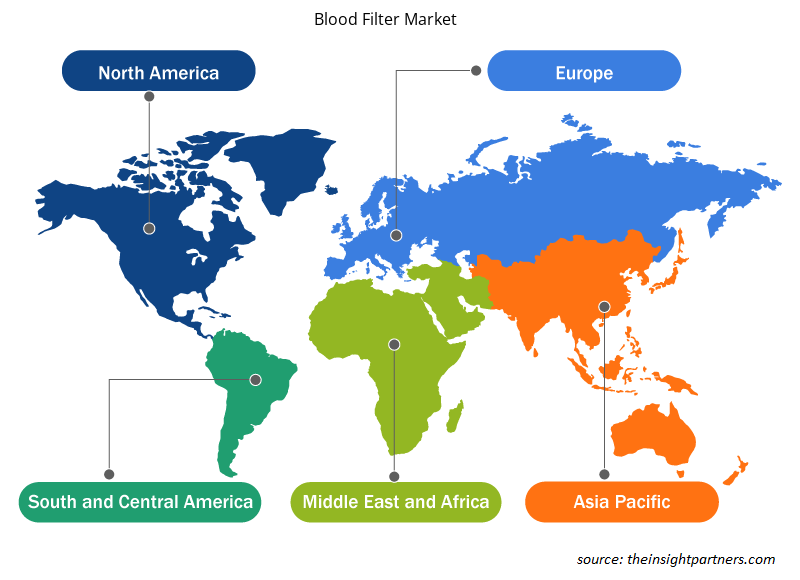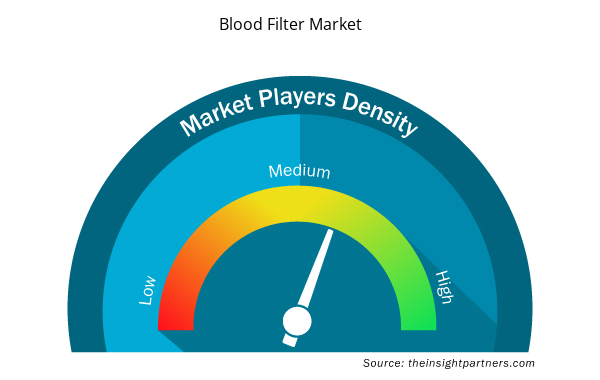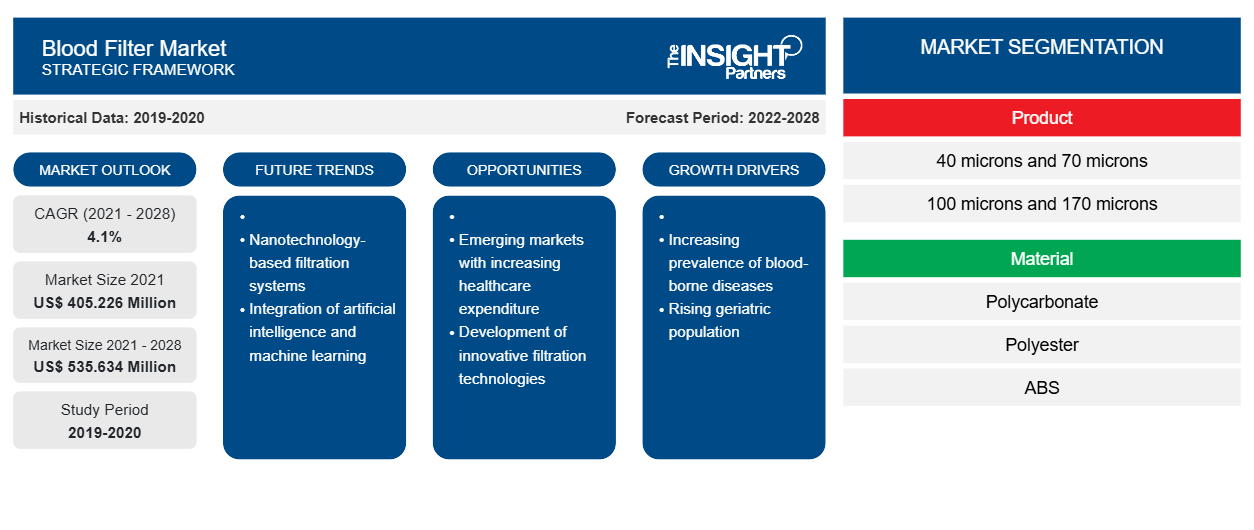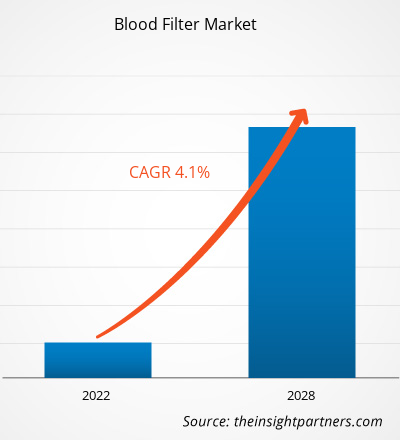Se proyecta que el mercado de filtros de sangre alcance los US$ 535,634 millones para 2028 desde los US$ 405,226 millones en 2021; se estima que crecerá a una CAGR del 4,1% entre 2021 y 2028.
Un filtro de sangre es un filtro tipo pantalla compuesto de una malla tejida hecha de poliéster o nailon, y se coloca entre la bolsa del producto y el paciente para realizar la filtración. Estos filtros están destinados a proteger a los pacientes de los macroagregados y las partículas de componentes no sanguíneos que podrían ser peligrosas si ingresan al torrente sanguíneo. Eliminan macroagregados como sitios de microagregados y agregados de fibrina durante una transfusión de sangre . La filtración implica capturar partículas y macroagregados hechos de leucocitos , fibrina y plaquetas, que se forman durante el almacenamiento de sangre. Factores como un aumento en la carga de enfermedades crónicas, un aumento en los casos de traumatismos y accidentes y un número creciente de procedimientos de transfusión de sangre impulsan el crecimiento del mercado de filtros de sangre . Sin embargo, las retiradas de productos obstaculizan el crecimiento del mercado.
Personalice este informe según sus necesidades
Obtendrá personalización en cualquier informe, sin cargo, incluidas partes de este informe o análisis a nivel de país, paquete de datos de Excel, así como también grandes ofertas y descuentos para empresas emergentes y universidades.
- Obtenga las principales tendencias clave del mercado de este informe.Esta muestra GRATUITA incluirá análisis de datos, desde tendencias del mercado hasta estimaciones y pronósticos.
Perspectivas del mercado
El creciente número de procedimientos de transfusión sanguínea impulsa el crecimiento del mercado de filtros de sangre
La mejora de la disponibilidad de sangre segura y adecuada para los procedimientos de transfusión debería ser parte integral de la política y la infraestructura sanitaria nacionales de cada país. La necesidad de transfusiones de sangre puede surgir en cualquier momento en las zonas urbanas y rurales. En el pasado, la falta de disponibilidad de sangre ha provocado la muerte de muchos pacientes que padecían problemas de salud. Se puede garantizar un suministro adecuado y fiable de sangre segura si se dispone de instalaciones estables para donantes de sangre regulares, voluntarios y no remunerados. También son el grupo de donantes más seguro, ya que la prevalencia de infecciones transmitidas por la sangre es la más baja entre ellos.
Las cirugías más comunes que requieren transfusiones de sangre incluyen procedimientos cardiovasculares, procedimientos de cesárea y lesiones. Según estimaciones del Instituto Nacional del Corazón, los Pulmones y la Sangre y los Institutos Nacionales de Salud (NIH), en los EE. UU., más de 5 millones de personas requieren transfusiones de sangre cada año. Además, debido a las calamidades naturales y las bajas generalizadas, la demanda de transfusiones de sangre está aumentando en todo el mundo. Un aumento en la incidencia de trastornos sanguíneos como anemia, eritrocitosis , leucocitosis , leucopenia y trombocitosis también está impulsando el crecimiento del mercado de filtros de sangre. Según la OMS, la mayoría de los niños con talasemia nacen en países de bajos ingresos, donde el acceso a la transfusión de sangre es difícil o está disponible para un pequeño porcentaje de la población.
Los filtros de sangre que se utilizan en los procedimientos de transfusión son de malla tejida de poliéster o nailon; son filtros tipo pantalla que se colocan entre la bolsa del producto y el paciente. Estos filtros están diseñados para proteger a los pacientes de macroagregados potencialmente dañinos, como plaquetas, leucocitos y proteínas de fibrina, y de partículas no sanguíneas. En la mayoría de los países desarrollados, los filtros de transfusión de sangre son proporcionados por los gobiernos o por programas comunitarios. Por lo tanto, la disponibilidad de instalaciones adecuadas para la donación de sangre y los donantes voluntarios impulsa el número de procedimientos de transfusión de sangre, lo que impulsa el crecimiento del mercado de rellenos de sangre.
Perspectivas basadas en productos
Según el producto, el mercado de filtros de sangre se segmenta en 40 y 70 micrones, 100 y 170 micrones, entre otros. El segmento de 100 y 170 micrones tendrá la mayor participación de mercado en 2021 y se espera que registre una CAGR más alta durante el período de pronóstico.
Perspectivas basadas en materiales
Según el material, el mercado de filtros de sangre se segmenta en policarbonato , poliéster, ABS y otros. El segmento de poliéster tendría la mayor participación de mercado con un 35,47 % en 2021 y se espera que mantenga su dominio durante el período de pronóstico.
Perspectivas basadas en aplicaciones
Según la aplicación, el mercado de filtros de sangre se segmenta en procesamiento de sangre y transfusión de sangre. El segmento de transfusión de sangre tendrá la mayor participación de mercado con un 73,83 % en 2021 y se espera que mantenga su dominio durante el período de pronóstico.
Información basada en el usuario final
Según el usuario final, el mercado de filtros de sangre se segmenta en bancos de sangre, hospitales y otros. El segmento de bancos de sangre tendría la mayor participación de mercado del 47,38 % en 2021 y se espera que mantenga su dominio durante el período de pronóstico.
Varias empresas que operan en el mercado de filtros de sangre están adoptando estrategias como lanzamientos de productos, fusiones y adquisiciones, colaboraciones, innovaciones de productos y expansiones de carteras de productos para expandir su presencia en todo el mundo, mantener la marca y satisfacer la creciente demanda de los usuarios finales.
Perspectivas regionales del mercado de filtros de sangre
Los analistas de Insight Partners explicaron en detalle las tendencias y los factores regionales que influyen en el mercado de filtros de sangre durante el período de pronóstico. Esta sección también analiza los segmentos y la geografía del mercado de filtros de sangre en América del Norte, Europa, Asia Pacífico, Oriente Medio y África, y América del Sur y Central.

- Obtenga datos regionales específicos para el mercado de filtros de sangre
Alcance del informe de mercado de filtros de sangre
| Atributo del informe | Detalles |
|---|---|
| Tamaño del mercado en 2021 | US$ 405,226 millones |
| Tamaño del mercado en 2028 | US$ 535.634 millones |
| CAGR global (2021-2028) | 4,1% |
| Datos históricos | 2019-2020 |
| Período de pronóstico | 2022-2028 |
| Segmentos cubiertos | Por producto
|
| Regiones y países cubiertos | América del norte
|
| Líderes del mercado y perfiles de empresas clave |
|
Densidad de actores del mercado de filtros de sangre: comprensión de su impacto en la dinámica empresarial
El mercado de filtros de sangre está creciendo rápidamente, impulsado por la creciente demanda de los usuarios finales debido a factores como la evolución de las preferencias de los consumidores, los avances tecnológicos y una mayor conciencia de los beneficios del producto. A medida que aumenta la demanda, las empresas amplían sus ofertas, innovan para satisfacer las necesidades de los consumidores y aprovechan las tendencias emergentes, lo que impulsa aún más el crecimiento del mercado.
La densidad de actores del mercado se refiere a la distribución de las empresas o firmas que operan dentro de un mercado o industria en particular. Indica cuántos competidores (actores del mercado) están presentes en un espacio de mercado determinado en relación con su tamaño o valor total de mercado.
Las principales empresas que operan en el mercado de filtros de sangre son:
- Corporación Asahi Kasei
- Fresenius Kabi AG
- Macofarma
- Corporación Haemonetics
- Informado SA
Descargo de responsabilidad : Las empresas enumeradas anteriormente no están clasificadas en ningún orden particular.

- Obtenga una descripción general de los principales actores clave del mercado de filtros de sangre
Mercado de filtros de sangre: por producto
- 40 micrones y 70 micrones
- 100 micrones y 170 micrones
- Otros
Mercado de filtros de sangre: por material
- Policarbonato
- Poliéster
- abdominales
- Otros
Mercado de filtros de sangre: por aplicación
- Procesamiento de sangre
- Transfusión de sangre
Mercado de filtros de sangre: por usuario final
- Bancos de sangre
- Hospitales
- Otros
Mercado de filtros de sangre por geografía
- América del norte
- A NOSOTROS
- Canadá
- México
- Europa
- Francia
- Alemania
- Italia
- Reino Unido
- España
- Resto de Europa
- Asia Pacífico (APAC)
- Porcelana
- India
- Corea del Sur
- Japón
- Australia
- Resto de Asia Pacífico
- Oriente Medio y África (MEA)
- Sudáfrica
- Arabia Saudita
- Emiratos Árabes Unidos
- Resto de Oriente Medio y África
- América del Sur y Central (SCAM)
- Brasil
- Argentina
- Resto de América del Sur y Central
Perfiles de empresas
- Corporación Asahi Kasei
- Fresenius Kabi AG
- Macofarma
- Corporación Haemonetics
- Informado SA
- CORPORACIÓN KANEKA
- Laboratorios Kawasumi. Inc.
- Sefar AG
- Implementos médicos de Shandong Zhongbaokang Co., Ltd.
- Nanjing Shuangwei Biotecnología Co., Ltd.
- Análisis histórico (2 años), año base, pronóstico (7 años) con CAGR
- Análisis PEST y FODA
- Tamaño del mercado Valor/volumen: global, regional, nacional
- Industria y panorama competitivo
- Conjunto de datos de Excel



Report Coverage
Revenue forecast, Company Analysis, Industry landscape, Growth factors, and Trends

Segment Covered
This text is related
to segments covered.

Regional Scope
North America, Europe, Asia Pacific, Middle East & Africa, South & Central America

Country Scope
This text is related
to country scope.
Preguntas frecuentes
Global blood filter market is segmented by region into North America, Europe, Asia Pacific, Middle East & Africa, and South & Central America. In North America, The US holds the largest size of the market in this region. Nearly 16 million blood components are transfused each year in the U.S. According to the American Cancer Society, more than 1.8 million people are expected to be diagnosed with cancer in 2020. Many of them will need blood, sometimes daily, during their chemotherapy treatment. Blood products are transfused through intravenous tubing with filters. The filters, which typically have pore diameters of 170 to 260 microns, are used to prevent particulate debris from being administered as well. The trapped material promotes bacterial growth, and the American Association of Blood Banks (AABB) recommends not using a filter for more than 4 hours. The government is also experiencing increasing chronic conditions such as acute kidney injury (AKI), multiple organ dysfunction syndromes, or sepsis. Thus, it is expected that rising incidences of chronic diseases are likely to influence the market's growth. Moreover, the rise in transplant procedures across the United States is expected to increase the blood transfer procedures that require collection units such as tubes, bags, and others. According to the Red Cross Blood Center, 4.5 million Americans require blood transfusion annually.
The blood filter market majorly consists of players such Asahi Kasei Corporation, Fresenius Kabi AG, Macopharma, Haemonetics Corporation, Infomed SA, KANEKA CORPORATION, Kawasumi laboratories. Inc., Sefar AG, Shandong Zhongbaokang Medical Implements Co., Ltd, Nanjing Shuangwei Biotechnology Co., Ltd. among others.
The blood transfusion segment dominated the global blood filter market and accounted for the largest revenue share of 73.83% in 2021
The blood banks segment dominated the global colon blood filter market and accounted for the largest revenue share of 47.38% in 2021.
A blood filter is a screen-type filter composed of woven mesh made from polyester or nylon, and it is placed between the product bag and the patient for performing filtration. These filters are intended to protect patients from macro-aggregates and non-blood component particulate matter that could be hazardous if enter the bloodstream. They remove macro-aggregates such as micro-aggregate sites and fibrin aggregates during a blood transfusion. Filtration involves capturing particles and macro-aggregates made from leucocytes, fibrin, and platelets, formed during blood storage.
Key factors that are driving the growth of this market are an increase in the burden of chronic diseases, a surge in cases of trauma and accidents, and a rising number of blood transfusion procedures are expected to boost the market growth for the blood filter over the years.
The 100micron and 170-micron segment dominated the global blood filter market and held the largest revenue share of 56.80% in 2021.
The polyester segment dominated the global blood filter market and held the largest revenue share of 35.47% in 2021.
Trends and growth analysis reports related to Life Sciences : READ MORE..
The List of Companies - Blood Filter Market
- Asahi Kasei Corporation
- Fresenius Kabi AG
- Macopharma
- Haemonetics Corporation
- Infomed SA
- KANEKA CORPORATION
- Kawasumi laboratories. Inc.
- Sefar AG
- Shandong Zhongbaokang Medical Implements Co., Ltd.
- Nanjing Shuangwei Biotechnology Co., Ltd.
The Insight Partners performs research in 4 major stages: Data Collection & Secondary Research, Primary Research, Data Analysis and Data Triangulation & Final Review.
- Data Collection and Secondary Research:
As a market research and consulting firm operating from a decade, we have published and advised several client across the globe. First step for any study will start with an assessment of currently available data and insights from existing reports. Further, historical and current market information is collected from Investor Presentations, Annual Reports, SEC Filings, etc., and other information related to company’s performance and market positioning are gathered from Paid Databases (Factiva, Hoovers, and Reuters) and various other publications available in public domain.
Several associations trade associates, technical forums, institutes, societies and organization are accessed to gain technical as well as market related insights through their publications such as research papers, blogs and press releases related to the studies are referred to get cues about the market. Further, white papers, journals, magazines, and other news articles published in last 3 years are scrutinized and analyzed to understand the current market trends.
- Primary Research:
The primarily interview analysis comprise of data obtained from industry participants interview and answers to survey questions gathered by in-house primary team.
For primary research, interviews are conducted with industry experts/CEOs/Marketing Managers/VPs/Subject Matter Experts from both demand and supply side to get a 360-degree view of the market. The primary team conducts several interviews based on the complexity of the markets to understand the various market trends and dynamics which makes research more credible and precise.
A typical research interview fulfils the following functions:
- Provides first-hand information on the market size, market trends, growth trends, competitive landscape, and outlook
- Validates and strengthens in-house secondary research findings
- Develops the analysis team’s expertise and market understanding
Primary research involves email interactions and telephone interviews for each market, category, segment, and sub-segment across geographies. The participants who typically take part in such a process include, but are not limited to:
- Industry participants: VPs, business development managers, market intelligence managers and national sales managers
- Outside experts: Valuation experts, research analysts and key opinion leaders specializing in the electronics and semiconductor industry.
Below is the breakup of our primary respondents by company, designation, and region:

Once we receive the confirmation from primary research sources or primary respondents, we finalize the base year market estimation and forecast the data as per the macroeconomic and microeconomic factors assessed during data collection.
- Data Analysis:
Once data is validated through both secondary as well as primary respondents, we finalize the market estimations by hypothesis formulation and factor analysis at regional and country level.
- Macro-Economic Factor Analysis:
We analyse macroeconomic indicators such the gross domestic product (GDP), increase in the demand for goods and services across industries, technological advancement, regional economic growth, governmental policies, the influence of COVID-19, PEST analysis, and other aspects. This analysis aids in setting benchmarks for various nations/regions and approximating market splits. Additionally, the general trend of the aforementioned components aid in determining the market's development possibilities.
- Country Level Data:
Various factors that are especially aligned to the country are taken into account to determine the market size for a certain area and country, including the presence of vendors, such as headquarters and offices, the country's GDP, demand patterns, and industry growth. To comprehend the market dynamics for the nation, a number of growth variables, inhibitors, application areas, and current market trends are researched. The aforementioned elements aid in determining the country's overall market's growth potential.
- Company Profile:
The “Table of Contents” is formulated by listing and analyzing more than 25 - 30 companies operating in the market ecosystem across geographies. However, we profile only 10 companies as a standard practice in our syndicate reports. These 10 companies comprise leading, emerging, and regional players. Nonetheless, our analysis is not restricted to the 10 listed companies, we also analyze other companies present in the market to develop a holistic view and understand the prevailing trends. The “Company Profiles” section in the report covers key facts, business description, products & services, financial information, SWOT analysis, and key developments. The financial information presented is extracted from the annual reports and official documents of the publicly listed companies. Upon collecting the information for the sections of respective companies, we verify them via various primary sources and then compile the data in respective company profiles. The company level information helps us in deriving the base number as well as in forecasting the market size.
- Developing Base Number:
Aggregation of sales statistics (2020-2022) and macro-economic factor, and other secondary and primary research insights are utilized to arrive at base number and related market shares for 2022. The data gaps are identified in this step and relevant market data is analyzed, collected from paid primary interviews or databases. On finalizing the base year market size, forecasts are developed on the basis of macro-economic, industry and market growth factors and company level analysis.
- Data Triangulation and Final Review:
The market findings and base year market size calculations are validated from supply as well as demand side. Demand side validations are based on macro-economic factor analysis and benchmarks for respective regions and countries. In case of supply side validations, revenues of major companies are estimated (in case not available) based on industry benchmark, approximate number of employees, product portfolio, and primary interviews revenues are gathered. Further revenue from target product/service segment is assessed to avoid overshooting of market statistics. In case of heavy deviations between supply and demand side values, all thes steps are repeated to achieve synchronization.
We follow an iterative model, wherein we share our research findings with Subject Matter Experts (SME’s) and Key Opinion Leaders (KOLs) until consensus view of the market is not formulated – this model negates any drastic deviation in the opinions of experts. Only validated and universally acceptable research findings are quoted in our reports.
We have important check points that we use to validate our research findings – which we call – data triangulation, where we validate the information, we generate from secondary sources with primary interviews and then we re-validate with our internal data bases and Subject matter experts. This comprehensive model enables us to deliver high quality, reliable data in shortest possible time.


 Obtenga una muestra gratuita de este informe
Obtenga una muestra gratuita de este informe